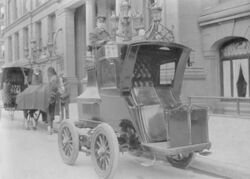Electric Vehicle Company
Topic: Company
 From HandWiki - Reading time: 4 min
From HandWiki - Reading time: 4 min
 Electric Vehicle Co. Hansom Cab, ca. 1904 | |
| Industry | Automotive industry , Patent holding company |
|---|---|
| Fate | Bankrupted |
| Predecessors |
|
| Founded | September 27, 1897 in New York City |
| Founders | Isaac Rice |
| Defunct | 1907 |
| Headquarters | New York City |
Key people |
|
| Products | Electric cars, Selden Patent |
| Brands |
|
| Owners |
|
Electric Vehicle Company was an American automobile holding company and early pioneering manufacturer of automobiles.
History
The Electric Vehicle Company was founded September 27, 1897 as a holding company of battery-powered electric vehicle manufacturers made up of several companies assembled by Isaac Rice.[1][2] Rice had acquired in May, 1897 another electric cab manufacturer, the Electric Carriage & Wagon Company (E.C.W.C.) in New York. Their vehicles were constructed by Henry G. Morris and Pedro G. Salom, builders of the Electrobats, the first truly useful electric automobiles in the USA.[3] E.V.W.C. pioneered a cab system that included service stations for quick change of battery sets, and repair work; vehicles were leased only, not sold. Twelve of these cabs were in use in Manhattan in January, 1897.[4] After the merger, E.C.V. concentrated on building heavy but reliable electric cabs[1] which were built in the E.C.W.C. workshops. The rental system was for a short time run by E.V.C. Between 1897 and 1899, there were several hundred E.V.C. vehicles built.[5]
The company was taken over in 1899 by a syndicate around William C. Whitney, Thomas Fortune Ryan Anthony N. Brady, and P. A. B. Widener, thus forming the so-called "Lead Cab Trust," which hoped to develop a monopoly by placing electric cabs on the streets of major American cities, starting with New York City, Philadelphia, Chicago , Washington, D.C., and Boston. Although by 1899, E.V.C. was the largest motor car manufacturer in the United States[6] - a position lost to Oldsmobile in 1901 - this policy failed soon, as it was even then not able to sell as many vehicles as necessary for the task. The firm actually made and sold about two thousand electric cars, but fell into hard times in 1900 after facing competition from gas-powered (that is, petroleum fuelled) cars and legal problems stemming from these monopolistic practices, as well as scandal surrounding the poor performance of its vehicles. Whitney brought in industrial leader Albert Augustus Pope now, who brought the Columbia Automobile Company. The trust was reorganized as the parent company of several vehicle manufacturers, among them Columbia and the Riker Electric Vehicle Company, which was acquired in 1902. Electric Vehicle's chief asset was now the holding of the Selden Patent which established a right to royalties from all manufacturers of internal combustion engine vehicles. While this was initially lucrative, it led inevitably to opposition from the other manufacturers and expensive lawsuits, which ended with bankruptcy in 1907. The patent was valid until 1913, but lost its worth as the appellation court reduced it to vehicles with Brayton engines, of which none was used in a motor vehicle.
See also
- Columbia Automobile Company
- Electric Vehicle
- List of defunct United States automobile manufacturers
Notes
- ↑ 1.0 1.1 Kimes/Clark: Standard Catalogue of American Cars 1805–1942 (1996), p. 525
- ↑ "The Columbia Car: Reliable, Simple to Operate and Ready for Action". Archived from the original on 16 December 2013. https://web.archive.org/web/20131216054500/http://www.secondchancegarage.com/classic-car/columbia-3.cfm. Retrieved 16 December 2013.
- ↑ Kirsch: The Electric Vehicle and the Burden of History. 2000, p. 41.
- ↑ Flink: America Adopts the Automobile (1970), p. 25, 29
- ↑ Kimes/Clark: Standard Catalogue of American Cars 1805–1942 (1996), p. 357
- ↑ Kimes: Pioneers, Engineers, and Scoundrels. 2005, p. 89.
References
- David A. Kirsch: The Electric Vehicle and the Burden of History. Rutgers University Press, New Brunswick NJ/ London 2000, ISBN:0-8135-2809-7
- Ernest Henry Wakefield: History of the Electric Automobile; Battery-Only Powered Cars. edited by SAE (Society of Automotive Engineers). Warrendale PA 1970, ISBN:1-56091-299-5
- Clark, Henry Austin Jr. (1996). Kimes, Beverly Rae. ed. Standard Catalogue of American Cars 1805–1942 (3rd ed.). Iola, Wisconsin: Krause Publications. ISBN 0-87341-428-4.
- Kimes, Beverly Rae. SAE (Society of Automotive Engineers). ed. Pioneers, Engineers, and Scoundrels: The Dawn of the Automobile in America. Warrendale, Pennsylvania. ISBN 0-7680-1431-X.
- James J. Flink: America Adopts the Automobile - 1895–1910. Massachusetts Institute of Technology, 1970, ISBN:0-262-06036-1
- James J. Flink, The Automobile Age (Cambridge: MIT Press, 1988).
- G. N. Georgano (editor): Complete Encyclopedia of Motorcars, 1885 to the Present. 2nd edition. Dutton Press, New York 1973, ISBN:0-525-08351-0
External links
- The Selden Motor Wagon Photos of the vehicle, plus articles about the gestation of the patent and the lengthy lawsuit which followed
- secondchancegarage.com: The Columbia Car: Reliable, Simple to Operate and Ready for Action - Page 3: To The Electric Vehicle Trust (retrieved, 7 August 2014)
- The Automobile of 1904; Frank Leslie's Popular Monthly (January 1904), Americana Review, 725 Dongan Ave., Scotia NY (USA); published, 1904, deckt auch Importe ab (English)
- Encyclopædia Britannica: Hiram Percy Maxim (English) (retrieved, 7 August 2014)
- kcstudio.com: A.L. Riker - The early story in brief as it directly relates to the history of the Pope Manufacturing Company, the Electric Vehicle Company, and the Columbia cars (English) (retrieved, 4 January 2016)
- kcstudio.com: Charging up the electric cabs; Zeitungsberichte 1896–1898 (English) (retrieved, 4 January 2016)
 KSF
KSF